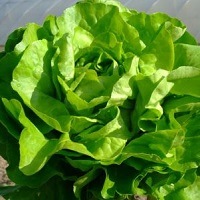Crop Type
Butterhead
Growing System
Indoor/outdoor
Planting Season
Year Round
Size
Large

Crop Type
Butterhead
Growing System
Indoor/outdoor
Planting Season
Year Round
Size
Large
Attention: This information and any complementary/other verbal or written information that may be given on behalf of Hazera, present average results of specific trials; these are neither exhaustive nor necessarily accurate and may not be regarded as advice, guidance, recommendation, representation or warranty. Sowing times and growing areas are indicative only. Pictures are illustrative only. The sale & use of seeds are subject to the terms and conditions appearing collectively on seed packages and in catalogues and/or at: http://www.hazera.com/terms-and-limitatons. E&OE. © 2022 Hazera. All rights reserved.
For tomatoes:
* Pod silną presją szkodników i/lub w niekorzystnych warunkach środowiskowych i/lub w obliczu nowych biotypów, patotypów, ras lub szczepów szkodników, które mogą się wyłonić odporne odmiany mogą wykazywać pewne objawy chorobowe lub uszkodzenia.
Temperatura gleby powyżej 27°C lub inne obciążenia mogą spowodować załamanie odporności na mątwika.
**Prosimy o zapoznanie się z definicjami ISF na stronie http://www.worldseed.org/wp-content/uploads/2017/05/Definition_on_reaction_plants_to_pests_2017_final.pdf
Egzemplarz definicji terminów opisujących reakcje roślin na szkodniki na potrzeby branży nasiennictwa roślin można uzyskać, na żądanie, w naszych biurach.
For all other crops:
* Pod silną presją szkodników i/lub w niekorzystnych warunkach środowiskowych i/lub w obliczu nowych biotypów, patotypów, ras lub szczepów szkodników, które mogą się wyłonić odporne odmiany mogą wykazywać pewne objawy chorobowe lub uszkodzenia.
**Prosimy o zapoznanie się z definicjami ISF na stronie http://www.worldseed.org/wp-content/uploads/2017/05/Definition_on_reaction_plants_to_pests_2017_final.pdf
Egzemplarz definicji terminów opisujących reakcje roślin na szkodniki na potrzeby branży nasiennictwa roślin można uzyskać, na żądanie, w naszych biurach.


Attention: This information and any complementary/other verbal or written information that may be given on behalf of Hazera, present average results of specific trials; these are neither exhaustive nor necessarily accurate and may not be regarded as advice, guidance, recommendation, representation or warranty. Sowing times and growing areas are indicative only. Pictures are illustrative only. The sale & use of seeds are subject to the terms and conditions appearing collectively on seed packages and in catalogues and/or at: http://www.hazera.com/terms-and-limitatons. E&OE. © 2022 Hazera. All rights reserved.
For tomatoes:
* Pod silną presją szkodników i/lub w niekorzystnych warunkach środowiskowych i/lub w obliczu nowych biotypów, patotypów, ras lub szczepów szkodników, które mogą się wyłonić odporne odmiany mogą wykazywać pewne objawy chorobowe lub uszkodzenia.
Temperatura gleby powyżej 27°C lub inne obciążenia mogą spowodować załamanie odporności na mątwika.
**Prosimy o zapoznanie się z definicjami ISF na stronie http://www.worldseed.org/wp-content/uploads/2017/05/Definition_on_reaction_plants_to_pests_2017_final.pdf
Egzemplarz definicji terminów opisujących reakcje roślin na szkodniki na potrzeby branży nasiennictwa roślin można uzyskać, na żądanie, w naszych biurach.
For all other crops:
* Pod silną presją szkodników i/lub w niekorzystnych warunkach środowiskowych i/lub w obliczu nowych biotypów, patotypów, ras lub szczepów szkodników, które mogą się wyłonić odporne odmiany mogą wykazywać pewne objawy chorobowe lub uszkodzenia.
**Prosimy o zapoznanie się z definicjami ISF na stronie http://www.worldseed.org/wp-content/uploads/2017/05/Definition_on_reaction_plants_to_pests_2017_final.pdf
Egzemplarz definicji terminów opisujących reakcje roślin na szkodniki na potrzeby branży nasiennictwa roślin można uzyskać, na żądanie, w naszych biurach.